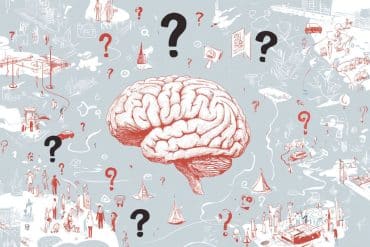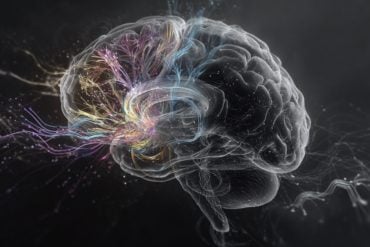Summary: Altered microRNA levels in a person’s saliva can help determine if they have experienced a recent concussion. The new saliva test is a cheap and non-invasive method for the identification of concussion.
Source: Penn State
Doctors may soon be able to more accurately diagnose concussions by measuring the number of certain molecules in a person’s saliva, according to Penn State College of Medicine researchers. The results of a recent clinical study confirmed that a patient’s spit may be used to aid concussion diagnosis in a non-invasive, non-biased fashion.
Researchers analyzed the saliva of more than 500 study participants for tiny strands of genetic material called micro ribonucleic acid (microRNA). These molecules play an important role in cellular processes and exist in high amounts in the brain. The investigators hypothesized that due to the presence of cranial nerves in the mouth, altered microRNA levels could indicate whether a patient is experiencing a concussion.
Concussions occur as a result of physical injury to the head and may result in short-lived symptoms including headaches, dizziness and confusion. Physicians currently use symptom scales and neurocognitive tests to assess patients and diagnose concussions. Researchers say these methods may not be reliable because they can be subject to patient and physician bias. For example, athletes may underreport a symptom’s severity to return to the field.
“Current methods rely on accurate symptom reporting and honest performance on neurocognitive testing,” said Dr. Steve Hicks, associate professor of pediatrics and principal investigator. “Analyzing microRNA profiles in saliva following a head trauma is a non-invasive way to test for concussion that can’t be influenced by a patient’s feelings or motives.”
To develop the diagnostic approach, researchers recruited 538 participants across 11 clinical sites. Approximately half the participants had a concussion reported within two weeks of starting the study, while the other half of participants did not, but had conditions that might mimic concussion symptoms including anxiety, depression, attention deficit hyperactivity disorder, exercise-related fatigue or chronic headaches.
The researchers used RNA sequencing to evaluate saliva samples from half of the participants, then used statistical modeling and machine learning to identify noticeable differences between the RNA profiles of participants with concussions and those without. Once they knew what RNA changes to look for, they tested more than 200 additional participants and were able to successfully identify which patients had concussions. The accuracy of the saliva approach performed favorably when compared with currently available tests involving balance and reaction time. The results were published in the journal Clinical and Translational Medicine.
“This method has lots of promising applications,” Hicks said. “A rapid, reliable diagnostic means that early, appropriate action can be taken to alleviate the symptoms of patients with concussions.”

Hicks said the work expands upon a smaller pilot study that showed microRNA could be used to predict the duration of concussion symptoms and that further effort is needed to develop the test into a portable technology that can be used field-side by athletic trainers immediately after an injury occurs, by emergency responders at the scene of an accident, or by army medics on a battlefield. He is working with Quadrant Biosciences, who recently received a grant to do a larger clinical study to validate the method and further develop the technology.
Cayce Onks, Raymond Kim, Kevin Zhen, Jayson Loeffert, Andrea Loeffert and Robert Olympia of Penn State College of Medicine; Gregory Fedorchak, Samantha DeVita and Aakanksha Rangnekar of Quadrant Biosciences; John Leddy and Mohammad Haider of State University of New York; Zofia Gagnon, Callan McLoughlin, Jason Randall and Miguel Madeira of Marist College; Aaron Yengo-Kahn and Justin Wenzel of Vanderbilt University Medical Center; Matthew Heller and Hallie Zwibel of New York Institute of Technology College of Osteopathic Medicine; Aaron Roberts and Samantha Johnson of Adena Regional Medical Center; Chuck Monteith, Colgate University; Michael Dretsch, Walter Reed Army Institute of Research; Thomas Campbell, Old Dominion University; Rebekah Mannix, Harvard Medical School and Christopher Neville and Frank Middleton of State University of New York Upstate Medical University also contributed to this research.
Funding: This project was supported by a sponsored research agreement between Quadrant Biosciences and the Penn State College of Medicine. National Center for Advancing Translational Sciences through Penn State Clinical and Translational Science Institute (UL1 TR002014) also supported this research. Hicks is a scholar in the institute’s Early Stage Investigator Training Program (KL2 TR002015). The content is solely the responsibility of the authors and does not necessarily represent the official views of the NIH.
Steve Hicks is a paid consultant for Quadrant Biosciences. Steve Hicks and Frank Middleton are scientific advisory board members for Quadrant Biosciences and are co-inventors of intellectual property related to saliva RNA biomarkers in concussion that are the subject of patent applications owned by the Penn State Research Foundation and the SUNY Upstate Research Foundation and licensed to Quadrant Biosciences. Samantha DeVita, Gregory Fedorchak and Aakanksha Rangnekar are paid employees of Quadrant Biosciences. Christopher Neville is a member of the scientific advisory board and has an equity interest in Quadrant Biosciences Inc. Material has been reviewed by the Walter Reed Army Institute of Research and there is no objection to its presentation and/or publication. The opinions and assertions contained herein are the private views of the author and are not to be construed as official, or as reflecting true views of the Department of the Army or the Department of Defense. The investigators have adhered to the policies for the protection of human subjects as prescribed in AR 70-25.
About this neurology and concussion research news
Source: Penn State
Contact: Barbara Schindo – Penn State
Image: The image is in the public domain
Original Research: Open access.
“Diagnosing mild traumatic brain injury using saliva RNA compared to cognitive and balance testing” by Steve Hicks et al. Clinical and Translational Medicine
Abstract
Diagnosing mild traumatic brain injury using saliva RNA compared to cognitive and balance testing
Background
Early, accurate diagnosis of mild traumatic brain injury (mTBI) can improve clinical outcomes for patients, but mTBI remains difficult to diagnose because of reliance on subjective symptom reports. An objective biomarker could increase diagnostic accuracy and improve clinical outcomes. The aim of this study was to assess the ability of salivary noncoding RNA (ncRNA) to serve as a diagnostic adjunct to current clinical tools. We hypothesized that saliva ncRNA levels would demonstrate comparable accuracy for identifying mTBI as measures of symptom burden, neurocognition, and balance.
Methods
This case‐control study involved 538 individuals. Participants included 251 individuals with mTBI, enrolled ≤14 days postinjury, from 11 clinical sites. Saliva samples (n = 679) were collected at five time points (≤3, 4‐7, 8‐14, 15‐30, and 31‐60 days post‐mTBI). Levels of ncRNAs (microRNAs, small nucleolar RNAs, and piwi‐interacting RNAs) were quantified within each sample using RNA sequencing. The first sample from each mTBI participant was compared to saliva samples from 287 controls. Samples were divided into testing (n = 430; mTBI = 201 and control = 239) and training sets (n = 108; mTBI = 50 and control = 58). The test set was used to identify ncRNA diagnostic candidates and create a diagnostic model. Model accuracy was assessed in the naïve test set.
Results
A model utilizing seven ncRNA ratios, along with participant age and chronic headache status, differentiated mTBI and control participants with a cross‐validated area under the curve (AUC) of .857 in the training set (95% CI, .816‐.903) and .823 in the naïve test set. In a subset of participants (n = 321; mTBI = 176 and control = 145) assessed for symptom burden (Post‐Concussion Symptom Scale), as well as neurocognition and balance (ClearEdge System), these clinical measures yielded cross‐validated AUC of .835 (95% CI, .782‐.880) and .853 (95% CI, .803‐.899), respectively. A model employing symptom burden and four neurocognitive measures identified mTBI participants with similar AUC (.888; CI, .845‐.925) as symptom burden and four ncRNAs (.932; 95% CI, .890‐.965).
Conclusion
Salivary ncRNA levels represent a noninvasive, biologic measure that can aid objective, accurate diagnosis of mTBI.






